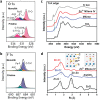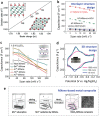Roles of Metal Ions in MXene Synthesis, Processing and Applications: A Perspective
- PMID: 35218319
- PMCID: PMC9036030
- DOI: 10.1002/advs.202200296
Roles of Metal Ions in MXene Synthesis, Processing and Applications: A Perspective
Abstract
With a decade of effort, significant progress has been achieved in the synthesis, processing, and applications of MXenes. Metal ions play many crucial roles, such as in MXene delamination, structure regulation, surface modification, MXene composite construction, and even some unique applications. The different roles of metal ions are attributed to their many interactions with MXenes and the unique nature of MXenes, including their layered structure, surface chemistry, and the existence of multi-valent transition metals. Interactions with metal ions are crucial for the energy storage of MXene electrodes, especially in metal ion batteries and supercapacitors with neutral electrolytes. This review aims to provide a good understanding of the interactions between metal ions and MXenes, including the classification and fundamental chemistry of their interactions, in order to achieve their more effective utilization and rational design. It also provides new perspectives on MXene evolution and exfoliation, which may suggest optimized synthesis strategies. In this respect, the different effects of metal ions on MXene synthesis and processing are clarified, and the corresponding mechanisms are elaborated. Research progress on the roles metal ions have in MXene applications is also introduced.
Keywords: MXenes; application; metal ion; processing; synthesis.
© 2022 The Authors. Advanced Science published by Wiley-VCH GmbH.
Conflict of interest statement
The authors declare no conflict of interest.
Figures













References
-
- Chia X., Pumera M., Nat. Catal. 2018, 1, 909.
-
- Yang Y., Hou H., Zou G., Shi W., Shuai H., Li J., Ji X., Nanoscale 2018, 11, 16. - PubMed
-
- Zeng M., Xiao Y., Liu J., Yang K., Fu L., Chem. Rev. 2018, 118, 6236. - PubMed
-
- Xue Y., Zhang Q., Wang W., Cao H., Yang Q., Fu L., Adv. Energy Mater. 2017, 7, 1602684.
-
- Tan C., Cao X., Wu X. J., He Q., Yang J., Zhang X., Chen J., Zhao W., Han S., Nam G. H., Sindoro M., Zhang H., Chem. Rev. 2017, 117, 6225. - PubMed
Publication types
Grants and funding
LinkOut - more resources
Full Text Sources
